If you’re here, it’s safe to assume you’re a construction company owner or manager interested in how GPS and Bluetooth tracking technologies can be best used to streamline your operations, minimize costs, and maximize productivity.
Concurrently, you might be wondering what the key differences between GPS trackers and Bluetooth beacons are and how these might affect your decision on what technology to use in specific construction scenarios.
If our assumptions are on-point, you’ll find the answers you need in this article.
In this article...
What Are GPS Trackers
GPS trackers are small devices that utilize the Global Positioning System (GPS) (network of satellites) to accurately determine the location of assets (vehicles, heavy machinery, other valuable equipment) and people in real-time.
In essence, GPS trackers are present in every smartphone, tablet, or other GPS-enabled device and can come preinstalled (e.g., in vehicles for navigation purposes) or as standalone devices (attached to whatever you want to track).
Other than tracking the location and movement of assets, GPS trackers can do the same for people wearing different wearables like smartwatches, smart safety vests, or worker ID badges.
For example, this personal GPS tracker is designed as a compact ID cardholder.
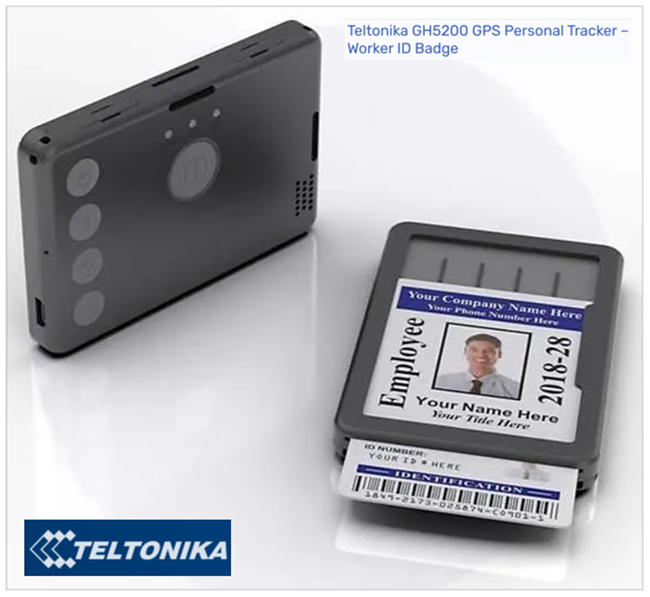
On a construction site, such wearable GPS trackers allow for enhanced safety and security, more efficient allocation of resources, and improved coordination among team members.
Whatever they’re tracking, GPS trackers send the location data (calculated with the help of satellite signals) to a central cloud database usually provided by the tracking software provider.
The tracking software (mobile app) then processes the received data and presents it in a user-friendly format, for example, by showing the locations of tracked equipment on a map.
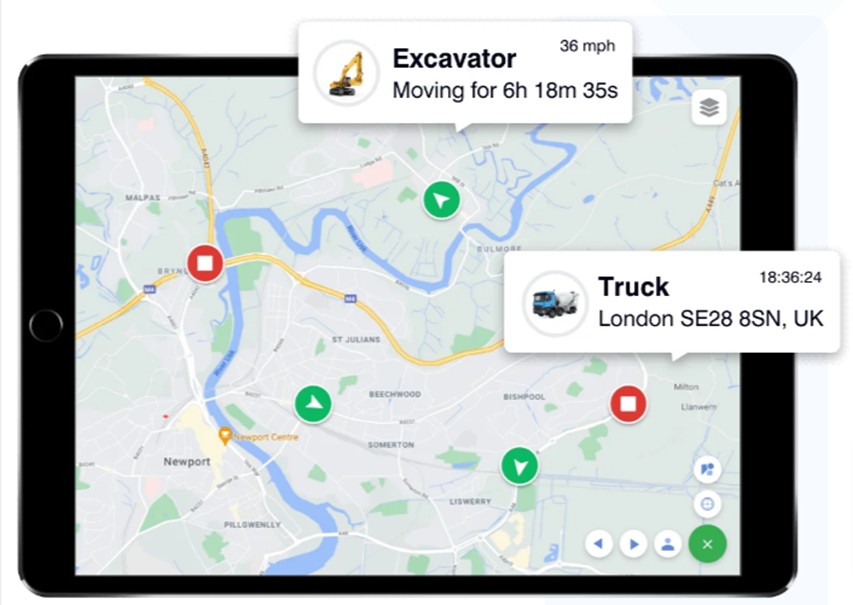
Moreover, GPS trackers can be combined with built-in or external sensors that provide a host of other real-time data that can be used to improve construction operations.
Depending on their specific application and requirements, GPS trackers offer a wide range of features, including real-time alerts, geofencing, and historical route tracking.
To sum up, GPS trackers are versatile devices that use satellites to provide accurate and continuous location data, which makes them ideal for tracking assets (or people) across vast construction sites (and between them) and in remote locations.
What Are Bluetooth Beacons
Bluetooth beacons (or tags, as we’ll explain) are small, battery-powered devices that use Bluetooth Low Energy (BLE) technology to transmit short radio signals.
When beacons are attached to assets like equipment and tools or worn by people, these signals are detected by nearby Bluetooth-enabled mobile devices like smartphones and tablets and/or dedicated standalone BLE signal receivers.
To complicate things, these fixed BLE signal receivers are often called beacons, while asset-tracking beacons are called tags.
Terminology aside, this tracking system setup involves strategically installing fixed receivers (anchors) across a construction site or warehouse, which then read the signals emitted by BLE beacons (tags).

Anchors receive the signals and deliver data to the central gateway, which sends it to the tracking software’s database for storage, analysis, and user-friendly presentation.
The end result is real-time tracking of assets/people within a specific area.
Again, the same result can be achieved without using stationary BLE receivers and relying only on one or more mobile devices to detect nearby beacons and convey that data to the tracking app.
This significantly reduces the price and simplifies implementing a Bluetooth tracking system, making it transferable from site to site.
Basically, all you need are beacons affixed to assets and mobile devices with the tracking app installed, and Bluetooth turned on.

It’s worth noting that BLE beacons and receivers are also used to control construction site access, improve site security, and enhance worker safety (as discussed later).
Overall, Bluetooth beacons are small signal-transmitting devices that, combined with mobile devices and/or fixed receivers, enable construction companies to utilize them for various purposes, primarily focusing on real-time location tracking within a limited range.
GPS Trackers vs Bluetooth Beacons: Key Differences
In this section, we’ll explore the key differences between GPS trackers and Bluetooth beacons to provide a better understanding of how these tracking methods compare in terms of technology, range, reliability, battery use, and cost.
Technology
GPS and Bluetooth technologies are two distinct and complementary methods for real-time tracking of construction resources (equipment, personnel, materials).
As mentioned, GPS receivers (an integral part of any GPS tracker) pick up signals from a network of satellites orbiting the Earth (Global Positioning System).
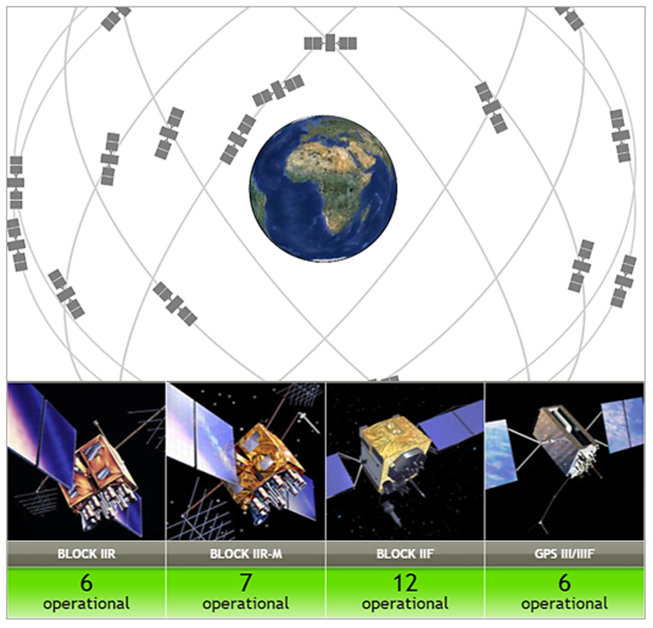
By triangulating these satellite signals, GPS trackers can precisely calculate their position and store that data for later retrieval (passive GPS) or transmit it in real-time (active GPS).
Active GPS trackers will calculate and update their position at regular intervals and transmit that data to the tracking software’s database, which will interpret it and show it in a user-friendly interface.
It should be noted that GPS locations of tracked assets can also be collected by utilizing GPS-enabled QR code tags.
Although these QR code tags do not have a GPS receiver, they utilize a smartphone’s or tablet’s GPS function when scanned, thus enabling tracking software to record the asset’s location.
Actually, that’s precisely what our asset-tracking app, GoCodes, uses as the primary tracking method while complementing the system with Bluetooth beacons.
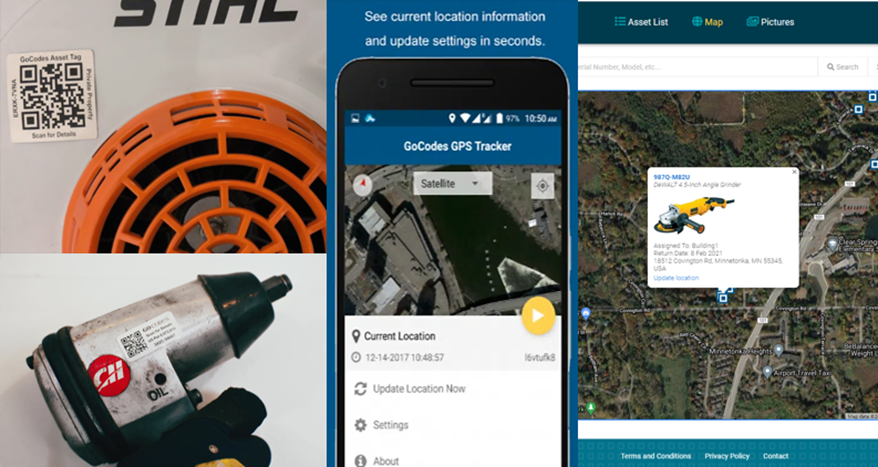
Acting in combination with active GPS trackers or as their alternative, this simple and affordable GPS-based tracking method can be combined with Bluetooth beacons to provide a comprehensive asset-tracking solution for construction companies.
Now let’s turn to BLE beacons.
Unlike GPS trackers and their long-range radio communication with satellites, beacons rely on transmitting short-range signals.
Here’s how a beacon-generated signal ends up in the cloud database.
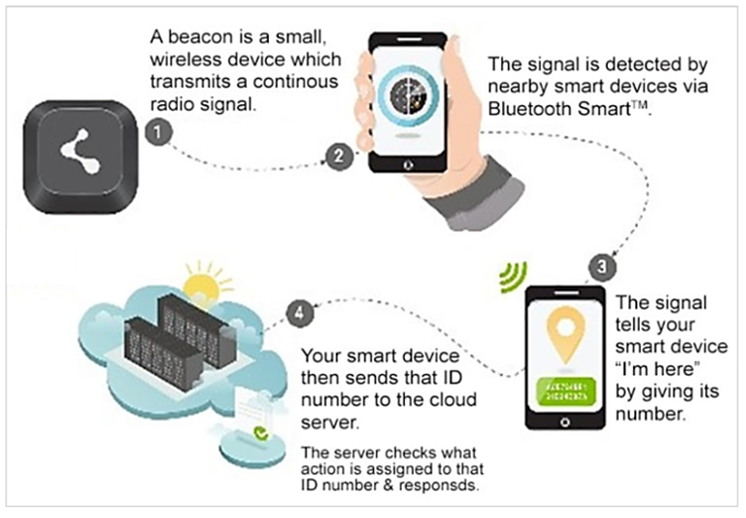
From there, the location data is processed and analyzed by specialized tracking software and delivered to app users in an understandable format.
It should be noted that BLE beacons typically only send signals.
These signals can contain:
- only their unique identifier, which BLE receivers use to identify the asset and determine their proximity to each detected beacon, or
- when sensor-enabled beacons are concerned, their identifier plus values measured by specific sensors (e.g., temperature, humidity, acceleration).
However, there are also two-way beacons that can receive BLE signals (messages) from the dedicated app, instructing them to perform different actions, such as optimizing battery capacity and beacon usage.
Similar to GPS trackers, when beacon-generated data is collected and processed by tracking software, construction companies can track their resources in real-time.
Range
In terms of receiving satellite signals, the range of GPS trackers is not limited by distance.
As long as the GPS tracker is outdoors and has an unobstructed view of the sky, it can receive signals from GPS satellites regardless of its location anywhere on Earth.
As for the GPS’s accuracy, satellite signals enable tracked assets to be located within 16 feet (4.9 meters).

Of course, numerous factors can reduce the accuracy of GPS tracking or lead to temporary signal loss, as we will discuss below.
The most-cited maximum range for Bluetooth beacons (and mobile/fixed signal receivers) is up to 300 feet (100 meters).
However, this range can vary widely depending on factors like signal strength and interference, physical barriers, and battery consumption.
Therefore, the range of Bluetooth beacons can be between 35 and 100 feet (10-30 meters).
Depending on the number of mobile/fixed signal receivers, the positioning accuracy of a BLE-based tracking system can be less than 10 feet (3 meters).
Reliability
As mentioned, GPS and Bluetooth technologies are based on radio signals, which means they’re subject to signal interference and potential signal loss.
GPS signals may be weakened or blocked by natural obstructions like mountains, thick forests, severe weather conditions, and artificial obstacles like tall buildings and dense urban environments.

Another disadvantage of satellite-based tracking is that underground areas, tunnels, and indoor environments interfere with or block the signal.
In comparison, Bluetooth technology suffers from similar constraints.
As beacon signals are short-range, physical obstructions like thick walls, large metal objects, and other electronic devices can reduce signal strength or cause signal reflection, thus affecting BLE beacons’ transmission range and accuracy.
These issues can be addressed by strategically positioning fixed BLE receivers in “blind spots” or increasing the number of mobile devices actively detecting beacon signals within the target area.
Battery Use
Generally, GPS trackers consume more power than Bluetooth beacons due to their continuous satellite communication and GPS data processing.
When installed in vehicles and equipment with their own power supply, GPS trackers can be connected to that power source and use batteries only when the vehicle or piece of equipment is not running.
Other types of GPS trackers can be exclusively battery-powered, and their battery life depends on factors like signal strength, tracking interval, and battery capacity, to name a few.
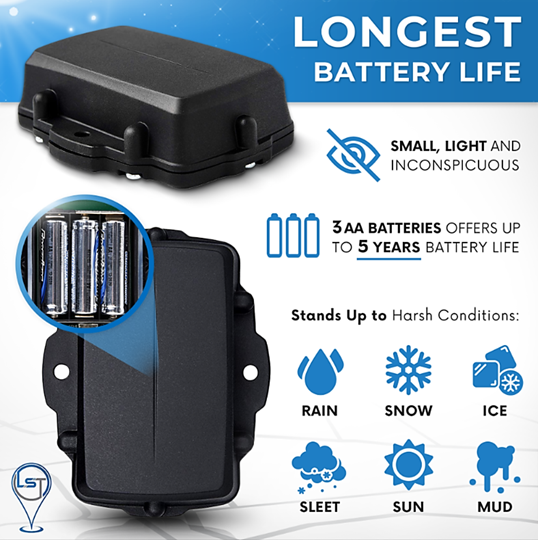
As you can see, GPS trackers are generally larger than Bluetooth beacons, so they can be fitted with larger, longer-lasting batteries.
On the other hand, BLE beacons are designed for low-power consumption.
As mentioned, they utilize Bluetooth Low Energy (BLE) technology, which is optimized for energy efficiency.
Additionally, BLE beacons transmit signals in regular intervals and do little or no data processing themselves, all of which contributes to longer battery life.
Cost
GPS trackers generally involve higher upfront costs due to more complex hardware, cellular connectivity, and associated components, particularly when tracking a fleet of construction vehicles and equipment.
The cost includes the purchase of GPS trackers, installation, and ongoing subscription fees for tracking software, which typically also cover cellular data plans.
Of course, the overall cost will depend on various factors, including the number of tracked assets, the tracking features required, and the specific use case.
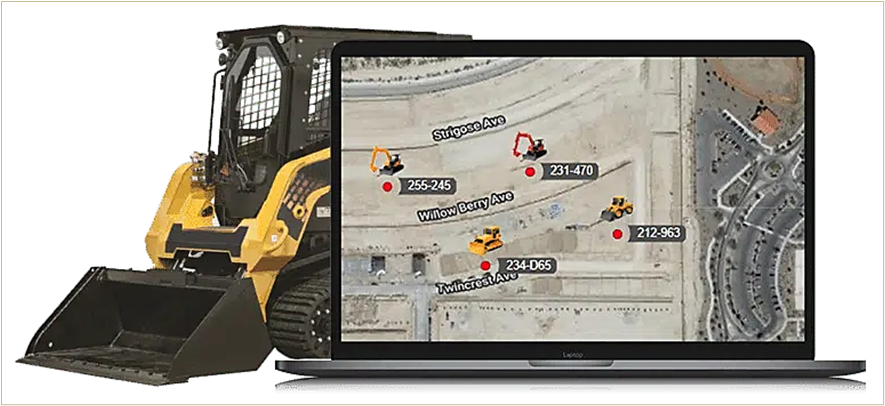
In comparison, BLE beacons offer a more cost-effective solution for tracking within a limited area, i.e., a job site or warehouse.
Beacons are relatively simple, energy-efficient devices, making them more affordable in terms of upfront costs than GPS trackers.
The cost of BLE tracking includes the price of beacons and potential fixed receivers, their installation, and monthly/annual tracking software subscription.
Therefore, the overall cost may significantly vary depending on the required infrastructure, namely the number of beacons and receivers needed for comprehensive coverage within the specified area.
What Should You Use GPS Trackers For
It’s clear that GPS trackers are highly versatile devices that offer a range of applications in the construction industry.
In other words, you can theoretically track anything fitted with a GPS receiver.
However, the price of GPS tracking hundreds or thousands of construction tools and equipment and/or workers in real-time would be very high.
Therefore, in a cost-effective asset-tracking system setup, GPS trackers are typically reserved for construction vehicles and heavy machinery.
Moreover, the GPS tracking of these assets brings construction companies the most benefits, such as navigation/route optimization, fuel consumption and driver behavior monitoring, as well as theft prevention.
You can see the benefits of using GPS to manage your construction fleet below.
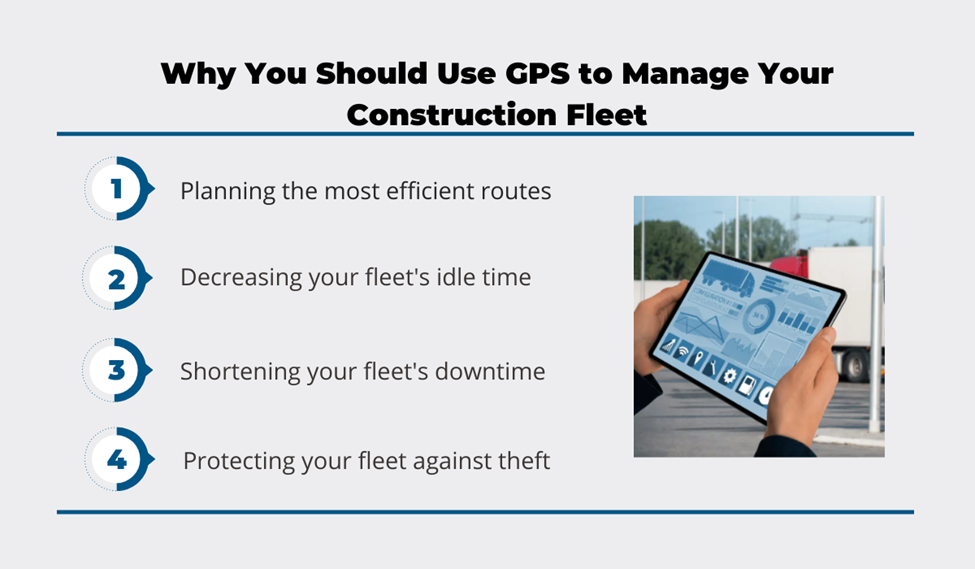
Naturally, other than vehicles and machinery, other valuable assets might be good candidates for real-time GPS tracking, such as generators, specialty equipment (cranes, pumps, drilling rigs), surveying equipment, and other high-value tools.
In addition, lone construction worker and/or personnel monitoring can be considered in specific safety situations.
Likewise, GPS trackers can be used for geofencing, i.e., establishing virtual boundaries to enhance security and safety by triggering alerts when assets or personnel enter or exit designated areas.
Overall, GPS trackers are best suited for outdoor, real-time tracking of vehicles and heavy machinery across vast distances.
What Should You Use Bluetooth Beacons For
As it’s clear from all we said about Bluetooth beacons, they’re best used for real-time location tracking of assets within a limited area, such as a construction site or warehouse.
They offer a cost-effective and highly reusable solution for tracking assets like tools and equipment, enabling construction companies to streamline their operations and minimize asset theft.
Bluetooth beacons can also be used for indoor navigation, site access control, and ensuring authorized personnel access to specific areas.
Additionally, they can be utilized to enhance worker safety by providing proximity alerts and tracking personnel movement within predefined zones.
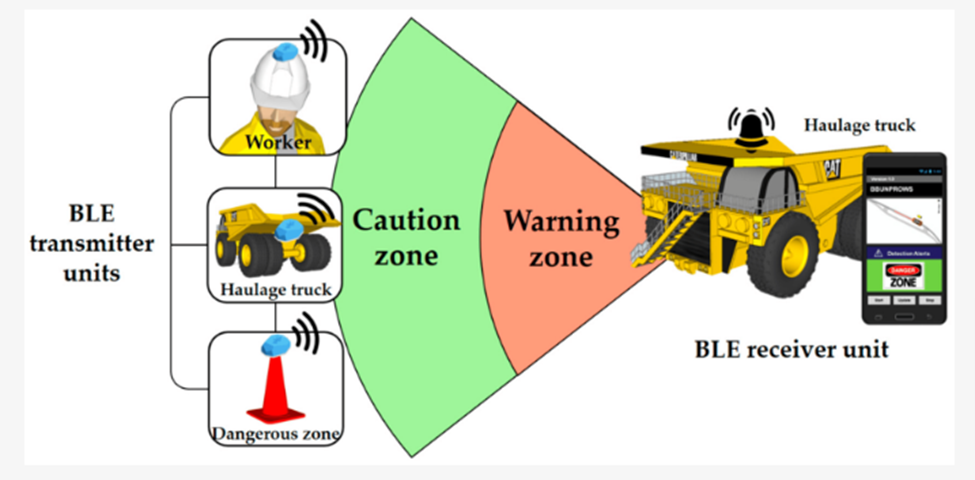
When sensor-enabled, beacons can monitor internal machine conditions or external environmental conditions.
Because of their practical and cost-effective use for asset tracking, beacons could be attached to all high-value equipment on-site, and mobile/fixed receivers used to track their location.
Even a single phone can be used to detect beacon-wearing equipment within its range and send alerts if tracked assets move out of range (see the GoCodes Guardian feature).
All in all, Bluetooth beacons offer affordability, flexibility, and portability, meaning beacons can move from asset to asset and the tracking system from site to site.
Last but not least, the location of small construction assets that can’t be fitted with either GPS trackers or BLE beacons (or whose value does not require it) can be tracked with GoCodes’ GPS QR codes regularly scanned by workers during an automated check-in/check-out process.
Conclusion
It’s clear that GPS trackers and Bluetooth beacons offer distinct, sometimes overlapping but often complementary, advantages in their various construction applications.
GPS trackers are ideal for outdoor, real-time tracking of vehicles, heavy machinery, and other valuable assets on the move, providing benefits such as navigation, fuel monitoring, and theft prevention.
Bluetooth beacons, on the other hand, excel in real-time location tracking within a limited area, particularly indoors, offering affordable and flexible solutions for tracking tools and equipment, enhancing worker safety and site security.
By weighing the costs and selecting the right combination of GPS-enabled and BLE-based tracking technologies, your company can efficiently and cost-effectively streamline operations, minimize costs, and maximize productivity.



